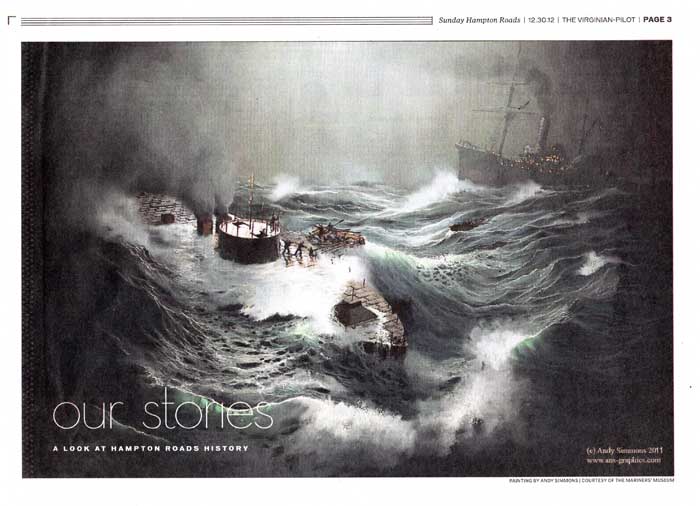NORFOLK NAVY YARD
Note: The materials used in this site are the personal property of Marcus W. Robbins, unless otherwise noted. In keeping with USGenWeb Archives policy of providing free information on the Internet, these documents may be used by anyone for their personal research. They may be used by non-commercial entities, when written permission is obtained from the contributor, so long as all notices and submitter information are included. These electronic pages may NOT be reproduced in any format for profit. Any other use, including copying files to other sites, requires permission from the contributors PRIOR to uploading to the other sites. The submitter has given permission to the USGenWeb Archives to store the file permanently for free access. If the reader has similar material they would like to share on this site, please contact Marcus W. Robbins.
BATTLE OF THE HAMPTON ROADS IRONCLADS
___________________________________________________________
Virginian-Pilot, December 30, 2012
IRONCLAD'S DOOM CALLED "A PANORAMA OF HORROR"
(Permission granted by author Paul Clancy to reprint this article.)One thing many of us in Hampton Roads have in common is putting out to sea. Whether on a Navy ship, cruise ship or sailing vessel, we've crossed the invisible barrier between bay and ocean, caught a glimpse of the Virginia Capes and let the thrill of adventure creep into our hearts.
And maybe, just maybe, a sense of dread.
Both of these emotions must have played on the mind of the officers and crew of the ironclad ship Monitor as the morning of December 30, 1862 - 150 years ago today - dawned clear and promising. They had parted company with the Capes in late afternoon the day before, and observed purple and crimson clouds as the sun set. It had been a balmy 58 degrees, and the sea looked like glass.
At dawn, there was a slight swell and a faint breeze from the southwest, but nothing to worry about. Sailors who had been cramped in the smoky engine room came out on deck and breathed the clean fresh air deeply.
But there was something else going on that only paymaster William Keeler seemed to notice: a bank of dark clouds in the western sky that gradually increased until it obscured the sun with its "cold gray mantle." A cold front was approaching.
By afternoon out on the Atlantic, winds began to freshen, with speeds up to 16 knots. That's nothing for most ships, or even many small boats, but for the half-submerged Monitor, it signaled trouble. For sailors now confined below while the ship pitched and yawed in the growing seas, it must have gone from slightly uncomfortable to just god-awful.
When the officers went down to dinner at sunset - around 4:45 p.m. - the talk was still of adventure, about how they were going to battle their way back to the glory they felt after the titanic clash with the Virginia, the South's ironclad. But when they climbed to the turret afterwards, all hell was breaking loose.
Seas were rolling over the deck and crashing into the turret. Gloom hung over everything and, as surgeon Grenville Weeks put it, "the moan of the ocean grew louder and more fearful."
An hour before midnight, a call of distress was sounded. The log on the tow ship Rhode Island shows that the Monitor "was in a sinking condition." Lifeboats were called out, and a treacherous dance of small boats and the ominously plunging ironclad began.
Most terrifying of all, several who tried to dash across the deck to the lifeboats were carried overboard by waves. Those who witnessed it were paralyzed by fear and refused orders to leave the turret. It was, as Keeler would write to his wife, "a panorama of horror."
Incredibly, some of the engine room crew stayed below as long as they could to keep the fires in the boilers going. All power on the doomed ship had been directed to the pumps, and these courageous acts may have bought a little bit of time.
"I stayed by the pump until the water was up to my knees and the cylinders to the pumping engines were under water and stopped," fireman George Geer would write to his brother. "She was so full of water and rolled and pitched so bad I was fearful she would roll under and forget to come up again."
There was a mad scramble among the remaining crew. Some were washed overboard only to be slammed against the side of the ship and scramble back to safety. Or be fished out of the water by boat crews. This was just the beginning because the boats had to be rowed against murderous seas before the men could be hoisted to safety.
Helplessly, survivors watched the Monitor's red emergency lantern flicker and then disappear. It was shortly before 2 a.m., New Year's Eve, when the ironclad slipped beneath the waves and rolled over as it fell to the ocean floor. Sixteen sailors were lost. It would be 14 decades until Navy divers would recover the turret and bring home for burial two of their own who were found there.
Today, the Mariners' Museum in Newport News will offer tours of the conservation area where the turret now rests. There will be a lecture and memorial ceremony.
And the recovered engine room gong will toll for the lost sailors.
* * * * * *
Paul Clancy, a former staff writer for The Pilot, is the author of 1) IRONCLAD: THE EPIC BATTLE, CALAMITOUS LOSS, AND HISTORIC RECOVERY OF THE USS MONITOR, 2) HISTORIC HAMPTON ROADS: WHERE AMERICA BEGAN and 3) HAMPTON ROADS CHRONICLES: HISTORY FROM THE BIRTHPLACE OF AMERICA.
